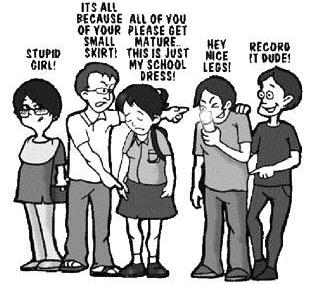
By Laura Flanders
Rape, and in particular acquaintance rape, has become something of a human interest story-of-choice for mainstream newspaper editors recently. But more coverage has usually not meant better.
When five St. John's University students were charged in the rape of a fellow student last spring, the New York Daily News went out of its way to present the assailants as more than just nice guys. "To Friends, a Fab 4" was the headline on one story (5/11/90) that quoted the men's lacrosse coach as saying, "They are the types to give something back to the community."
It isn't just tabloids that promote this theme. "After Rape Charge, 2 Lives Hurt and 1 Destroyed" was the New York Times headline (11/12/90) above astory about a University of Rhode Island student who committed suicide before giving testimony to police about a rape he had witnessed.
The story, by William Celes 3rd, presented the rape survivor and her attacker as equally "hurt," the real victim being the 20-year-old young man with "personal problems" who couldn't bear the memory of the assault he'd witnessed without trying to prevent. (Celes points out, however, that "some said the real victim was Mr. Lallymand," the man charged with the rape.)
Few facts are given about the survivors of the assaults in these stories, except the victim-blaming detail that the women were reportedly drunk at the time of their assaults. (This is mentioned twice in the Times' story.)
While there are conventions protecting the identity of rape victims, there is nothing to prevent them from being "humanized" at least as fully as their assailants. In neither of these stories was that even attempted. In a special report on rape on campus (New York Times, 1/2/91), Celes suggests why the Times might show equal or greater sympathy for rapists than for the women they assault. "Sexual activity that goes too far and becomes abhorrent to the woman is not new among college students," writes Celes. "But calling it date rape is,...defining sex between dates or acquaintances without the woman's consent as a form of male assault rather than a form of female error."
The report describes as "agony on campus," not the women's ordeal, but the confusion on campus stimulated by discussion of the subject. The old argument that men cannot help raping women is suggested -- co-ed dormitories are repeatedly blamed for the rise in rape on campus, although more rapes occur in single-sex fraternities.
But the underlying premise is that changing social relations have caused the problem: "Assumptions about the roles of men and women seem to be shifting, with a resulting confusion on both sides about what is and is not acceptable behavior." A new brand of "blame the victim," this thesis blames rape on the movement that fights for women's survival.
In his section on "Women," Celes quotes university administrators saying the problem is "partly the result of mixed signals sent by women." Even feminist author Susan Brownmiller is taken out of context to defend this blaming of the female, saying, "Women need to react more quickly."
Meanwhile, under the topic of "Men," the emphasis is not on individual responsibility. Interviewed sympathetically is a troubled young man who, after attending several workshops on the subject, had to admit that probably he had raped "some" of the women he had dated.
Syndicated columnist Mona Charen (Newsday, 1/9/91) blamed the feminist movement for eroding the "old sexual mores" that she seems to think once kept rape at bay. "While it seems plausible that reporting of date rape is up, it is obvious that there is simply much more of it than there used to be. And for this the feminist movement must take its share of the blame."
There is a lot of blame, and (to judge by the mainstream press) far too few feminists to take it. The Senate Judiciary Committee in June 1990 reported that rape is increasing four times as fast as the overall crime rate (Time, 10/1/90). One in five adult women has been raped, one in six by an acquaintance or a relative.
It is possible to treat violence against women in a way that helps to fight the crime. A three-part ABC News series on rape (1/7/91 through 1/11/91) included more insightful comments than a culling of print articles produced in a year. "Violence against women is done by men, and it's time that men took the responsibility to stop the violence," one male anti-rape activist was quoted. "What we want is the recognition that any sort of forced sexual contact is unacceptable, plain and simple," said Mary Ellen Shone of the King's County Sexual Assault Center.
But helpful reporting on rape is the exception, not the norm. Instead of hearing the cries of survivors, the press is hearing the complaints of apologists; instead of condemning cruelty, the press promotes excuses.

No comments:
Post a Comment